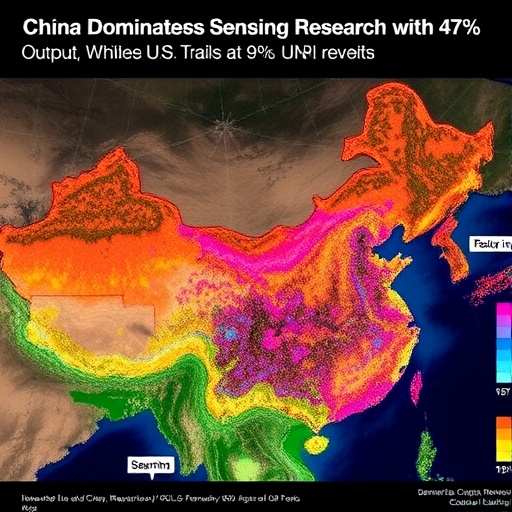The landscape of remote sensing research has undergone a dramatic transformation over the past several decades, with the United States experiencing a significant decline in its global standing relative to China. A recent comprehensive study reveals a substantial shift in publication output that showcases China’s ascendancy in this crucial technological domain. Today, China accounts for nearly half of all peer-reviewed journal articles related to remote sensing, an impressive feat that underscores its commitment to advancing this field. In stark contrast, American contributions to remote sensing research have plummeted to single-digit percentages.
The lead author of the study, Debra Laefer, a professor in the Civil and Urban Engineering department at NYU Tandon, put this dramatic change into perspective, stating that it represents one of the most significant shifts in technological leadership in contemporary history. As the research outlines, this decline from the U.S. dominance of 88% in the 1960s to a mere 9% today is alarming, especially given the rapid growth of interest and investment in remote sensing technologies.
Remote sensing encompasses a vital range of techniques for gathering detailed information from afar. Utilizing advanced technologies including laser scanning, aerial imagery, and satellite-data analytics, remote sensing informs critical applications that span autonomous vehicles, climate change monitoring, and national security developments. With a global market valued at approximately $452 billion in 2022—projected to soar to $1.44 trillion by 2030—the stakes for leadership in this arena have never been higher.
The recent study, which will be published in the journal “Geomatics,” analyzed over 126,000 publications spanning from 1961 to 2023. The authors determined that China’s exponential growth in remote sensing research can be traced back to a number of key factors. Historically, China maintained little presence in this field from the 1960s until the 1990s. However, a remarkable surge in output has occurred since that time, reflecting the nation’s increasing focus on developing technological capabilities.
One driving force behind this growth in publications is the significant decrease in equipment costs, allowing wider access to remote sensing technologies. Moreover, advancements in digital-only publishing and the incorporation of artificial intelligence techniques, such as machine learning and deep learning, have transformed the landscape of research in this area. The rise of AI-driven methodologies has enabled researchers to more efficiently analyze large datasets and generate innovative insights, further expediting the development of new applications in remote sensing.
Among the most striking revelations from the study relates to government funding: a near-perfect correlation exists between national investment in remote sensing and research output. Between 2021 and 2023, China’s National Natural Science Foundation appeared in funding acknowledgments for over 53% of remote sensing papers published, a striking statistic when compared to U.S. funding agencies, which contributed to just 5% of similar papers. Two organizations, NASA and the National Science Foundation (NSF), represent the majority of U.S. contributions, but their impact has significantly diminished compared to their historical influence.
China’s funding landscape has diversified, with six Chinese funding entities now listed among the top ten global supporters of remote sensing research, reflecting a robust national investment strategy. NASA, once a potent force, has seen its share decrease dramatically from years when it dominated funding in the field. The NSF lacks divisions focused specifically on geomatics or geodesy, further highlighting the challenges the United States faces in fostering innovation in a competitive global environment.
Intellectual property generation further compounds the implications of this research. Patent data illustrates that China currently leads in remote sensing patents filed globally, reversing the dominance the United States held in the late 20th century. In a mere three-year span from 2021 to 2023, the volume of “remote sensing” patents surged to over 43,000 worldwide, with Chinese entities filing the majority. This trend signals an urgent need for the U.S. to reevaluate its strategies for securing intellectual property in this pivotal technological sector.
An examination of publication titles reveals a notable shift in technological focuses over the decades. The early years of remote sensing research centered heavily on satellite imagery, but the past few years have witnessed an explosive incorporation of artificial intelligence techniques. Terms like “deep learning” and “machine learning” have exploded in prevalence, affirming the trend toward integrating advanced analytical methods into remote sensing research. The number of papers discussing these AI methodologies has reached an impressive total of over 80,000 by 2023, illustrating a growing recognition of their importance in driving innovation.
The implications of these findings extend deep into the technological fabric of nations. As various emerging technologies—including augmented reality, autonomous navigation, and digital twins—become increasingly reliant on sophisticated remote sensing capabilities, the competition becomes all the more pronounced. With Chinese investments continuing to surge and a tripling of the field’s commercial value expected by 2030, understanding the importance of these trends is crucial for policymakers and industry leaders alike.
In summary, the remarkable transformation of remote sensing research from an American stronghold to a Chinese-dominated field invites serious reflection on national strategies related to innovation and funding. As China continues to carve out its leadership role in this rapidly evolving landscape, the implications for U.S. competitiveness remain stark. The findings contained within this study offer critical insights into the direction of remote sensing research, highlighting the urgent need for a concerted effort to support and advance American contributions in a rapidly changing global landscape.
Subject of Research: Not applicable
Article Title: Remote Sensing Publications 1961–2023—Analysis of National and Global Trends
News Publication Date: 12-Sep-2025
Web References: http://dx.doi.org/10.3390/geomatics5030047
References: Not applicable
Image Credits: Not applicable
Keywords
Remote sensing, artificial intelligence, machine learning, global technology leadership, geographic data, national funding.




